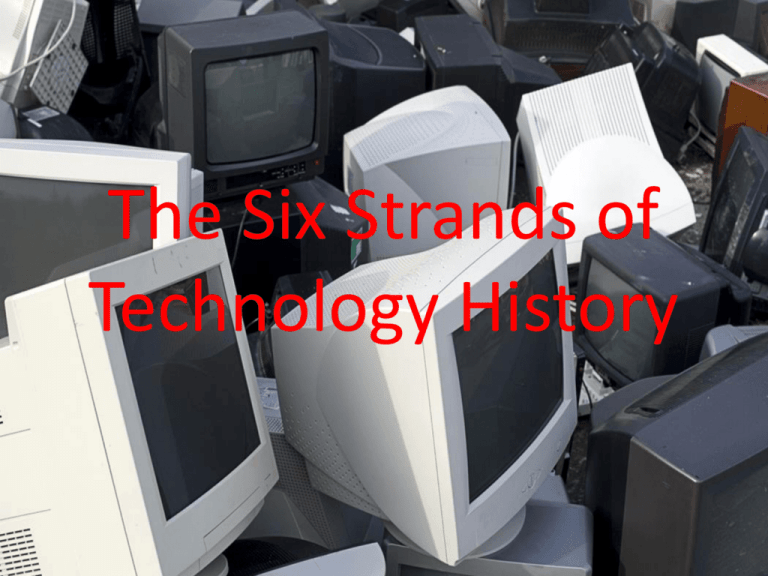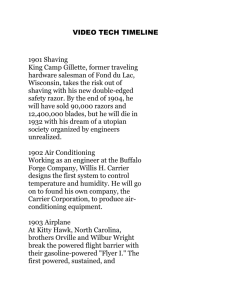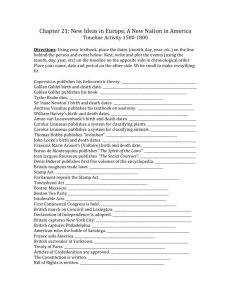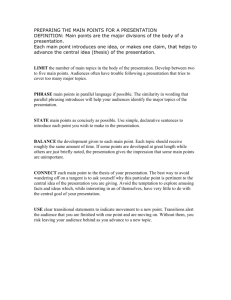The Six Strands of Technology History
advertisement

The Six Strands of Technology History Strand 1: Toffler’s Four Waves • • • • Agricultural Age Industrial Age Information Age Communication Age Agricultural Age (Jan.1, 1700-Dec. 31, 1899) • Alvin Toffler's First Wave began approximately 10,000 gathering what nature provided or failed to provide. They years ago. also started domesticating animals and herding of cattle. That time marked the end of the Old Stone Age (the Paleolithic) and the beginning of the New Stone Age or the Neolithic. This is approximately when the Agricultural Revolution started. People began clearing land and tilling the soil in order to plant crops as opposed to gathering what nature provided or failed to provide. They also started domesticating animals and herding of Industrial Age (Jan. 1, 1780- Jan. 1,1950) • Alvin Toffler's Second Wave was the Industrial Revolution. It ran for the most part from the late 18th to the early 20th century and brought with it mechanization as well as new production techniques such as the assembly line. During that period, the scale of manufacturing activity dramatically increased, giving rise to what we call today, mass production. • Information Age (Jan. 1, 1950-Jan. 1 2005) • According to Alvin Toffler, The Third Wave is generally what we refer to as the Information Age. It arose as a result of advances in computer technology and the advent of the Internet. We all have a pretty good idea of what this is about. In 1980 when he published his book, The Third Wave, computers were for the most part bulky mainframe units. Of course, the capacities, capabilities, and sizes have vastly changed since then. What used to take up an entire room now fits in your lap, if not within the palm of your hand. Communication Age (Jan. 1,1997- Jan. 1,2050) Strand 2: Technology: Key advances and innovations for each decades TECHNOLOGY 1900-1910 • 1901 Shaving King Camp Gillette, former traveling hardware salesman of Fond du Lac, Wisconsin, takes the risk out of shaving with his new double-edged safety razor. By the end of 1904, he will have sold 90,000 razors and 12,400,000 blades, but he will die in 1932 with his dream of a utopian society organized by engineers unrealized. 1902 Air Conditioning Working as an engineer at the Buffalo Forge Company, Willis H. Carrier designs the first system to control temperature and humidity. He will go on to found his own company, the Carrier Corporation, to produce air-conditioning equipment. 1903 Airplane At Kitty Hawk, North Carolina, brothers Orville and Wilbur Wright break the powered flight barrier with their gasoline-powered "Flyer I." The first powered, sustained, and controlled airplane flight in history lasts 12 seconds. Wilbur pilots the machine. On a flight later that day, Orville will remain aloft 59 seconds and travel 852 feet. 1908 Model T Car maker Henry Ford introduces his Model T automobile. By 1927, when it is discontinued, 15.5 million Models T's will be sold in the U.S. Ford owes much of his success to his improved assembly line process, which by 1913 will produce a complete Model T every 93 minutes TECHNOLOGY 1910-1920 • 1911 Self Starter Charles F. Kettering, who developed the electric cash register while working at National Cash Register, sells his electric automobile starters to the Cadillac company. This device increases the popularity of the gasoline-powered car, which no longer needs to be started with a hand crank. 1914 Panama Canal After 36 years' labor, the bankruptcy of thousands of investors, and the deaths of more than 25,000 men, the Panama Canal is finished. The canal cuts the sailing distance from the East Coast to the West Coast by more than 8,000 miles. 1917 War U.S. troops arrive on the battlefields of Europe, where new technologies have created the bloodiest conflict in history. Armored tanks, machine guns, poisonous gas, submarines and airplanes will force military commanders to rethink traditional strategies of war. 1919 Hydrofoil Alexander Grahams Bell's "Hydrodome IV" sets a world record of 70 mph for water travel. The boat weighs over 10,000 pounds and uses underwater fins to raise the hull of the boat and decrease drag between the hull and the water. 1920 KDKA The first regular commercial radio broadcasts begin when AM station KDKA of Pittsburgh delivers results of the Harding-Cox election to its listeners. Radio experiences immediate success; by the end of 1922, 563 other licensed stations will join KDKA. • TECHNOLOGY 1920-1930 1921 Wirephoto The first electronically-transmitted photograph is sent by Western Union. The idea for a facsimile transmission was first proposed by Scottish clockmaker Alexander Bain in 1843. 1924 Execution In an effort to make capital punishment more humane, the State of Nevada introduces death by gas chamber. Convicted murderer Gee John takes 6 minutes to die. 1926 Rocket Robert H. Goddard, Professor of Physics at Clark University in Worcester, Massachusetts, makes the first successful launch of a liquid-fueled rocket at his aunt Effie's farm in Auburn, Massachusetts. The rocket reaches 41 ft. in altitude. 1927 Television Philo Farnsworth demonstrates the first television for potential investors by broadcasting the image of a dollar sign. Farnsworth receives backing and applies for a patent, but ongoing patent battles with RCA will prevent Farnsworth from earning his share of the million-dollar industry his invention will create. 1929 Frozen Food Clarence Birdseye offers his quick-frozen foods to the public. Birdseye got the idea during fur-trapping expeditions to Labrador in 1912 and 1916, where he saw the natives use freezing to preserve foods. TECHNOLOGY 1930-1940 • 1931 Radio Astronomy While trying to track down a source of electrical interference on telephone transmissions, Karl Guthe Jansky of Bell Telephone Laboratories discovers radio waves emanating from stars in outer space. 1932 Defibrillator Working at the research facilities at Johns Hopkins University, Dr. William Bennett Kouwenhoven develops a device for jump-starting the heart with a burst of electricity. 1937 Chair Lift Skiers no longer have to climb hills to enjoy their sport. Engineers from the Union Pacific Railroad build a chair lift for the Dollar Mountain resort in Sun Valley, Idaho. Dollar Mountain follows with an order for six more. 1938 Nylon A team of researchers working under Wallace H. Carothers at E.I. du Pont de Nemours & Company invents a plastic that can be drawn into strong, silk-like fibers. Nylon will soon become popular as a fabric for hosiery as well as industrial applications such as cordage. 1939 Digital Computer John Atanasoff and Clifford Berry of Iowa State College complete the prototype of the first digital computer. It can store data and perform addition and subtractions using binary code. The next generation of the machine will be abandoned before it is completed due to the onset of World War II. TECHNOLOGY 1940-1950 • 1940 Jeep Karl K. Pabst of the Bantam Car. Co., Butler, Pennsylvania, produces a four-wheel drive vehicle that will become famous as the jeep. Given its name by its military designation, G.P., or general purpose, the jeep will be used for numerous transport applications throughout World War II, and will become a popular domestic vehicle after the war. 1942 Atomic Reaction A team working under Italian refugee Enrico Fermi at the University of Chicago produces the first controlled, self-sustaining nuclear chain reaction. This experiment and others will result in the development of the atomic bomb. 1945 Atomic Bomb A team led by J.R. Oppenheimer, Arthur H. Compton, Enrico Fermi and Léo Szilard detonates the first atomic bomb at the Los Alamos Lab near Santa Fé, New Mexico. Following the tests, the United States dropped two atomic bombs on Japan -- one at Hiroshima, one at Nagasaki -- that claimed more than 100,000 lives. 1947 Polaroid Camera Dr. Edwin H. Land introduces a new camera that can produce a developed photographic image in sixty seconds. Land will follow in the 1960s with a color model and eventually receive more than 500 patents for his innovations in light and plastics technologies. 1948 Electric Guitar Leo Fender launches the guitars that built rock and roll when he debuts his Broadcaster solid-bodied electric guitar. Later renamed the Telecaster, the guitar will become a favorite with guitar slingers worldwide. TECHNOLOGY 1950-1960 • 1951 UNIVAC 1 The Eckert and Mauchly Computer Co. of Philadelphia sells the first commercial computer, the UNIVAC 1, to the U.S. Census Bureau. The memory called up data by transmitting sonic pulses through tubes of mercury. An additional 45 UNIVAC 1 machines would eventually be sold. 1953 Heart-lung Machine Dr. John H. Gibbon performs the first successful open heart surgery in which the blood is artificially circulated and oxygenated by a heart-lung machine. This new technology, which allows the surgeon to operate on a dry and motionless heart, greatly increases surgical treatment options for heart defects and disease. 1955 Nuclear Submarine The Nautilus, the first nuclear submarine, revolutionizes naval warfare. Conventional submarines need two engines: a diesel engine to travel on the surface and an electric engine to travel submerged, where oxygen for a diesel engine is not available. The Nautilus, the first nuclear sub, can travel many thousands of miles below the surface with a single fuel charge. 1957 Polio Vaccine Dr. Albert Sabin develops a polio vaccine using strains of polio too weak to cause infection but strong enough to activate the human immune system. His invention will put an end to the polio epidemics that have crippled thousands of children worldwide. 1958 Explorer I Three months after the Soviet Union began the Space Age by launching Sputnik, the U.S. responds by sending the Explorer I satellite into orbit. Explorer I's mission is to detect radiation; it discovers one of the Van Allen radiation belts. TECHNOLOGY 1960-1970 • 1960 Laser Working at Hughes Research Laboratories, physicist Theodore H. Maiman creates the first laser. The core of his laser consists of a man-made ruby -- a material that had been judged unsuitable by other scientists, who rejected crystal cores in favor of various gases. 1964 Operating System IBM rolls out the OS/360, the first mass-produced computer operating system. Using the OS/360, all computers in the IBM 360 family could run any software program. Already IBM is a giant in the computer industry, controlling 70% of the market worldwide. 1965 Minicomputer Digital Equipment introduces the PDP-8, the world's first computer to use integrated circuit technology. Because of its relatively small size and its low $18,000 price tag, Digital sells several hundred units. 1969 Moon Landing Millions watch worldwide as the landing module of NASA's Apollo 11 spacecraft touches down on the moon's surface and Neil Armstrong becomes the first human to set foot on the moon. President John F. Kennedy, who vowed to the world that the United States would put a human on the moon before 1970, has not lived to witness the moment. • TECHNOLOGY 1970-1980 1970 Optical Fiber Corning Glass announces it has created a glass fiber so clear that it can communicate pulses of light. GTE and AT&T will soon begin experiments to transmit sound and image data using fiber optics, which will transform the communications industry. 1972 Video Game Pong, one of the first mass-produced video games, has become the rage. Noland Bushnell, the 28 yearold inventor of Pong, will go on to found Atari. 1974 Barcode The first shipments of bar-coded products arrive in American stores. Scanners at checkout stations read the codes using laser technology. The hand-punched keyboard cash register takes one step closer to obsolescence. 1975 Microsoft Old high school friends Bill Gates and Paul Allen form a partnership known as Microsoft to write computer software. They sell their first software to Ed Roberts at MIT, which has produced the Altair 8800, the first microprocessor-based computer. Gates soon drops out of Harvard. 1976 Super Computer Cray Research, Inc. introduces its first supercomputer, the Cray-1, which can perform operations at a rate of 240,000,000 calculations per second. Supercomputers designed by Seymour Cray will continue to dominate the market; the Cray 2, marketed in 1985, will be capable of 1,200,000,000 calculations per second. 1979 Human-Powered Flight Cyclist Byron Allen crosses the English Channel in a pedal-powered aircraft called the Gossamer Albatross. The flight takes 2 hours, 49 minutes, and wins a [sterling]100,000 prize for its crew, headed by designer Dr. Paul MacCready. Constructed of Mylar, polystyrene, and carbon-fiber rods, the Albatross has a wingspan of 93 feet 10 inches and weighs about 70 pounds. • TECHNOLOGY 1980-1990 1981 Space Shuttle For the first time, NASA successfully launches and lands its reusable spacecraft, the Space Shuttle. The shuttle can be used for a number of applications, including launch, retrieval, and repair of satellites and as a laboratory for physical experiments. While extremely successful, the shuttle program will suffer a disaster in 1986 when the shuttle Challenger explodes after takeoff, killing all on board. 1982 Artificial Heart Dr. Robert Jarvik implants a permanent artificial heart, the Jarvik 7, into Dr. Barney Clark. The heart, powered by an external compressor, keeps Clark alive for 112 days. 1983 PC In January "Time" names its 1982 "man" of the year -- the personal computer. PC's have taken the world by storm, dramatically changing the way people communicate. IBM dominates the personal computer market, benefiting both from the production of its own machines as well as "clones" produced by other companies. 1985 Genetic Engineering The USDA gives the go-ahead for the sale of the first genetically altered organism. The rapidly growing biotech industry will seek numerous patents, including one for a tomato that can be shipped when ripe. 1990 Hubble Telescope The space shuttle Discovery deploys the Hubble Space telescope 350 miles above the Earth. Although initial flaws limit its capabilities, the Hubble will be responsible for numerous discoveries and advances in the understanding of space. TECHNOLOGY 1990-2000 • In 1992 the World Wide Web was released to the public,[12] by 1996, the Internet was in the mainstream consciousness and many businesses listed websites in their ads. By 1999, almost every country had a connection, and more than half of Americans used the Internet on a regular basis. • In 1989, 15% of households in the United States owned computers, by 2000, this was up to 51 TECHNOLOGY 2000-2010 • Cell phones became a common sight in western countries, with movie theaters beginning to show ads telling people to silence their phones. • After revolutionizing society in the developed world in the 1990s, the digital revolution spread to the masses in the developing world in the 2000s. • In late 2005 the population of the Internet reached 1 billion,[14] and 3 billion people worldwide used cell phones by the end of the decade. Currently, television are transitioning from analogue to digital signal. • The link between mobile devices and internet webpage's via "social networking" have become a standard in digital communication. By 2010, 2 billion people used the Internet, double the number using it in 2005. By 2015, tablets and phones are expected to exceed personal computers in Internet usage. [15] Strand 3: Work: Business and corporate philosophies by decade WORK 1900-1910 • 1900- Us Steel Corporation organized • 1902- Approximately 150 thousand United Mine Workers strike for wage increase • 1913- Labor Department established • 1914- World War 1 began in Europe WORK 1920-1930 • 1921- The Black Labor Party strike of mine workers failed • 1929- Stock Market crashed on the 24th of October, was called “Black Thursday” began the Great Depression • 1930- Unemployment rate was high • 1934- 100 million acres were ruined by the Dust Storm and 200 million acres of cropland • 1938- Fair Labor Standards Act establishes minimum wages WORK 1940-1950 • 1940- FIRST Social Security benefit checks are paid out January 30th • 1941- Japanese attack on Pearl Harbor starts World War II • 1943- The president freezes prices, salaries and wages to prevent inflation • 1947- Taft-Hartley Act passed • 1950-1953- Korean War • 1955- AFL and CIO merge and becomes AFL-CIO • 1955-1975 Vietnam War WORK1960-1970 • 1963- Equal Pay Act passes • 1969- ATM began operating in New York • 1972- Watergate Scandal WORK 1980-1990 • 1980- The Federal Hourly Wage was set to $3.10 an hour • 1980- 60,000 oil refinery workers strike • 1980- Unemployment rate 7.1 percent • 1991- The Persian Gulf War (January 16thApril 6th) • 1993- North American Free Trade Agreement passes • 1998- Google WORK 2000-2010 • 2004- Congress extends tax cuts • 2005- Hurricane Katrina leaves millions homeless and 1,000 died • 2007- Minimum wages goes from $5.15per hour to $5.85 • 2009- Wages went to $7.25 per hour • 2009- Unemployment reaches 9.3 percent Strand 4: Education: Important theories of learning and instruction by decade EDUCATION 1900-1910 • 1901- Dewey publishes Psychology and How We Think describing his Functional Theories • 1912- Frederic Burk developed one of the first individual instruction systems • 1913- Thorndike’s Connectionism of Learning = Stimulus-Responses became the leading educational psychology • 1919- The Winnetka Plan was developed by Carleton W. Washburn which provided self-instructional and self-corrective practice materials EDUCATION 1920-1930 • 1920- Kurt Lewin’s Field Theory and a Science of Instruction • 1922- Dewey publishes Human Nature and Conduct describing the interaction of the individual and his environment • 1925-1935- Henry Clinton Morrison’s Morris Plan • 1929- Piaget present his learning theory of genetic epistemology. Learning is the construction of meaning • 1938- Skinner publishes Behavior of Organism that repopularizes behaviorist classroom models. EDUCATION 1940-1950 • 1953- Burrhus Frederic (B.F.) Skinner & apos’s Science and Human Behavior is published. His form of behaviorism (operant conditioning), which emphasizes changes in behavior due to reinforcement, becomes widely accepted and influences many aspects of American education • 1954- Skinner publishes the science of Learning and the Art of Teaching. • 1956- Edward Bloom Blooms Taxonomy EDUCATION 1960-1970 • 1962- Vygotsky publishes Thought and Language that explores social development theories of learning. • 1965- The Elementary and Secondary Education Act (ESEA) is passed. • 1966- Bruner publishes Toward a Theory of instruction where he introduces Constructivist Learning Theory. • 1977- Sternberg publishes Intelligence, Information Processing, and Analogical Reasoning informing a Triarchic Learning Theory EDUCATION 1980-1990 • 1982- Gardner publishes Art Mind and brain in which he introduces his Multiple intelligences Learning Theory. • 1982- Madeline C. Hunter & apos;s book. Mastery Teaching, is published. • 1985- Microsoft Windows 1.0, the first independent version of Windows is released . EDUCATION 2000- 2010 • 2000- David Wiley LODAS Learning Object Design and Sequencing. • 2001- The controversial No Child Left Behind Act (NCLB) is approved by Congress and signed into law. • 2003- Ruth Clark Efficiency of Learning Strand 5: Society and culture: Events that determined the thinking of each decade SOCIETY AND CULTURE 1900-1910 • 1903- Wright brothers make the first controlled, sustained flight in heavier-than-air aircraft at Kitty Hawk, N.C. • 1906- San Francisco earthquake and three-day fire; more than 500 dead. • 1907- First blood transfusion with human blood. • 1916- Polio epidemic in the US. • 1918- Worldwide influenza epidemic strikes; by 1920, nearly 20 million are dead. In U.S., 500,000 perish. SOCIETY AND CULTURE 1920-1930 • • • • • • 1920- Women gained the right to vote 1922- Insulin discovered 1928- Penicillin discovered 1928- First Mickey Mouse Cartoon 1931- Empire State Building completed 1933- Prohibition ends. SOCIETY AND CULTURE 1940-1950 • 1944- D Day • 1946- Dr. Spock’s common Book on Baby and Childcare • 1950- First “Peanuts” Cartoon Strip • 1952- Car seatbelt introduced • 1954- Segregation ruled illegal in the US SOCIETY AND CULTURE 1960-1970 • 1964- Civil Rights Act Passes in the US • 1965- New York City black out • 1967- First heart transplant • 1969- Sesame Street airs • 1973- Roe versus Wade SOCIETY AND CULTURE 1980-1990 • 1981- New plague identified as AIDS • 1982- Michael Jackson’s song “Thriller” introduced • 1986- Challenger Space Shuttle explodes • 1999- Killing spree at Columbine High School SOCIETY AND CULTURE 2000-2010 • 2000- George W. Bush accepts the presidency following questions about ballots • 2000- Y2K Bug • 2000- Mapping the human genome Strand 6: Political POLITICAL 1900-1910 • 1902- Cuba gains independence from Spain • 1905- Russian Revolution “Bloody Sunday” • 1907- Second Hague Peace Conference • 1909- National Association of Colored People founded by W.E.B DuBois POLITICAL 1920-1930 • 1920- 19TH Amendment ratified Women’s Suffrage • 1923- Adolf Hitler & apos;s “Beer Hall Putsch” in Munich fails; in 1924 he is sentenced to five years in prison where he writes Mein Kampf • 1924- Teapot Dome Scandal • 1932- Famine is widespread in the U.S.S.R. POLITICAL 1940-1950 • 1940- Winston Churchill becomes Britain’s Prime Minister. • 1941- First US Lend Lease shipment of food sent to Britain • 1942- Declaration of United nations is signed in Washington • 1950- Korean War begins POLITICAL 1960-1970 • 1963- John F Kennedy assassinated • 1964- Civil Rights Act signed • 1972- Watergate Scandal • 1974- US President Nixon resigns POLITICAL 1980-1990 • 1981- Sandra Day O Connor first woman appointed to Supreme Court • 1985- PLO terrorist hijack the AchilleLauro cruise ship • 1986- President Regan freezes Libyiaassests POLITICAL 2000-2010 • 2000- Mad Cow Disease alarms Europe • 2001- September 11th terrorist attack on the US • 2001- 178 nations reach an agreement on climate and global warming







